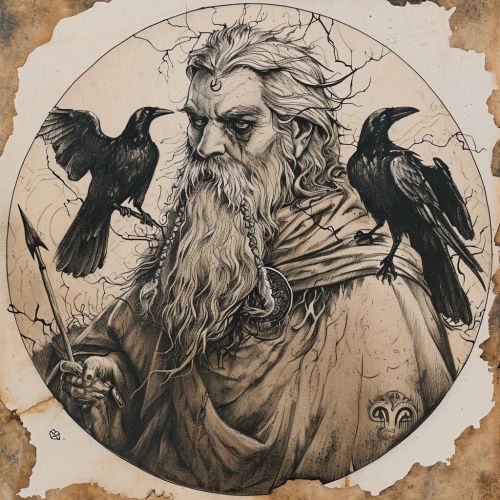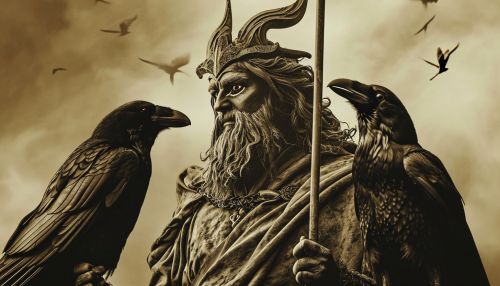Odin
Origins
Odin is a major god in Norse mythology and the ruler of Asgard, one of the nine worlds in Norse cosmology. He is associated with wisdom, healing, death, royalty, the gallows, knowledge, war, battle, victory, sorcery, poetry, frenzy, and the runic alphabet, and is the husband of the goddess Frigg.


Odin's origins are complex and multifaceted. He is often considered the chief of the Æsir, a group of deities in Norse mythology. However, his role and characteristics have evolved significantly over time, reflecting the changing needs and beliefs of the societies that worshipped him.
Characteristics
Odin is often depicted as a one-eyed, long-bearded, white-haired old man, cloaked in a blue-black robe and carrying a spear named Gungnir, fashioned by the dwarfs. He is accompanied by his animal companions—the wolves Geri and Freki, and the ravens Huginn and Muninn, who bring him information from all over Midgard—and rides the flying, eight-legged steed Sleipnir across the sky and into the underworld.
Odin is a relentless seeker after knowledge and wisdom and is willing to sacrifice almost anything for this pursuit. The most outstanding feature of his appearance, his one eye, attests to this; he sacrificed his other eye for more wisdom. He is also the discoverer of the runes, and the giver of their magical powers to humans.
Worship and Rituals
Odin was worshipped as the chief god of the Norse pantheon. His followers conducted various rituals to honor him and seek his favor, particularly before and during battles. One of the most notable rituals was the blót, a sacrifice to the gods, in which participants would feast on the meat of a sacrificed animal and drink mead in Odin's honor.
Odin in Literature
Odin appears prominently in a wide range of texts from the Norse and Germanic literary traditions. In the Poetic Edda and the Prose Edda, two of the most important sources of Norse mythology, Odin is a central character, and many of the poems and stories revolve around his exploits.
Modern Influence
Odin's influence extends into modern times. He is a popular figure in modern media and culture, appearing in various forms in literature, movies, video games, and other forms of entertainment. He is often portrayed as a wise but distant ruler, a powerful warrior, or a cunning trickster, reflecting his complex and multifaceted nature in the original myths.
